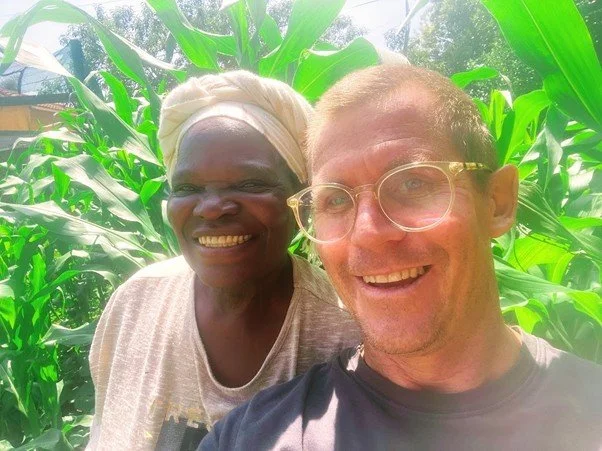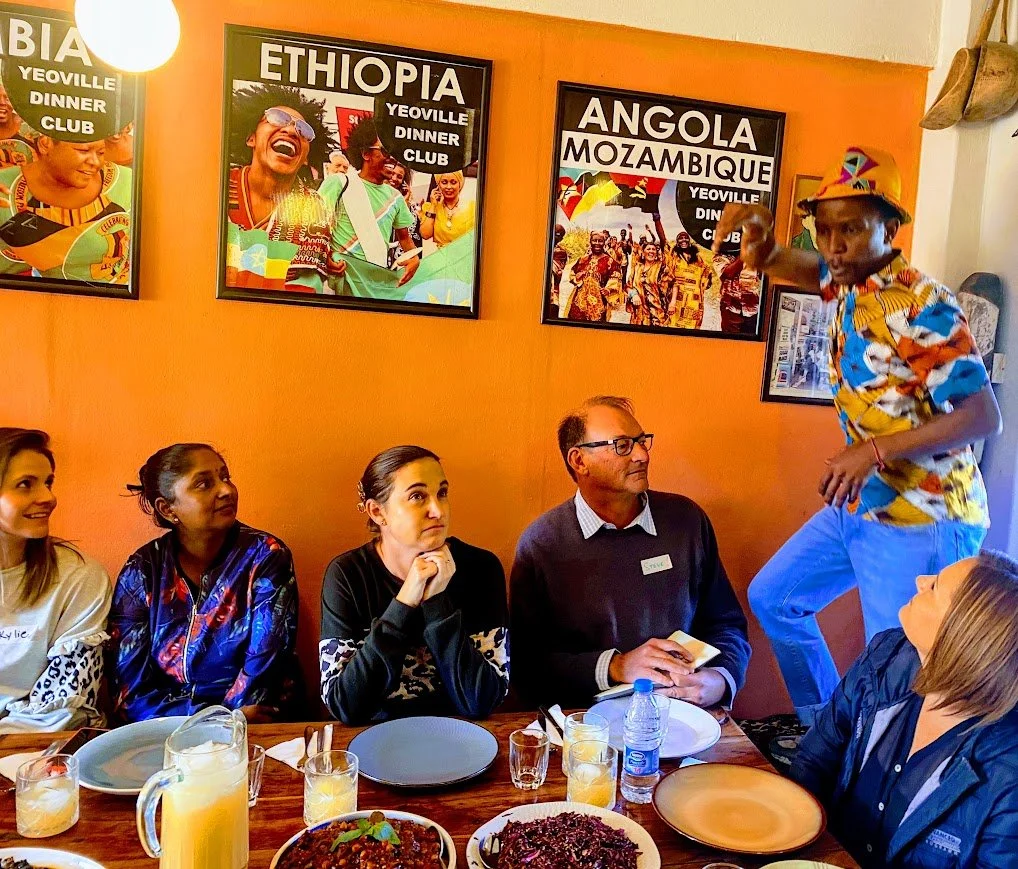The Head, Heart, and Hands of Immersive Learning
I have lived by immersing myself in the diversity of life. I have learnt everything this way.
I love stepping out of my front door and exploring something new and unfamiliar to me. It is a never-ending process of renewal. I love meeting people who challenge my ideas, and who inspire me to step further out there.
I love visiting people who live outside of my life, who are a root system within their own communities, and whose roots have become intertwined with my own.
I go and sit with Ma Refilwe in her garden next to Sun City prison, and we eat fruit or veggies, and she holds my hands in prayer for the goodness of the earth.
I take great joy in meeting people who have started with nothing and built up an impressive business from the most humble beginnings, and sitting with them to hear their story, just like I did with Harriet and her Mother the other day at their recycling plant in Boxberg.
Going to share a Pan African meal and some Ethiopian coffee with my dear friend and world-class Chef, Sanza, in Yeoville, Rocky Street, is a regular treat,
I consider myself rich when it comes to people who inspire me to keep going no matter what.
This is why I believe so strongly in Immersive Learning as the most powerful tool we have to challenge ourselves.
What Is an Immersion?
People often ask me this. Some imagine it as a medical procedure or a profound, cultish ceremony. It’s neither (unless that’s what a client needs!). Simply put, an immersion, or immersive experience, is:
“An experience in which people are exposed to the reality of people, situations and events they have never encountered before, or have little understanding of, so they can be challenged to see things differently, do things differently, and get different outcomes."
Immersions are designed to provoke thinking, pull on heartstrings, and challenge perspectives about people, places, and situations that individuals would otherwise never experience firsthand.
Why Immersions Matter
Traditional classroom learning, with its focus on theory and passive absorption, often fails to engage the brain in ways that foster deep understanding and retention. Neuroscience shows that learning is most effective when it engages the head (thinking), heart (feeling), and hands (doing). Immersions bridge this gap by creating sensory, reality-based experiences that activate all three dimensions of learning.
The Neuroscience of Immersive Learning
Recent research in neuroplasticity—the brain’s ability to reorganize itself by forming new neural connections—reveals that learning thrives on novelty, challenge, and relevance. Immersions naturally incorporate these elements by placing individuals in unfamiliar situations that demand adaptation and critical thinking.
Moreover, the concept of “embodied cognition” highlights the importance of physical movement and sensory experiences in processing information. When participants engage in hands-on activities or step into real-world scenarios, they’re not just learning—they’re developing motor skills, spatial awareness, and emotional connections. This multi-sensory engagement strengthens memory retention and deepens understanding.
Building Flexibility and Agility Through Immersions
In today’s rapidly changing world, flexibility and agility are essential skills for both individuals and organizations. Immersions are uniquely positioned to cultivate these qualities by thrusting participants into unfamiliar environments where they must adapt, think on their feet, and navigate uncertainty.
Cognitive Flexibility: Exposure to new cultures and challenges rewires the brain, enabling participants to approach problems from multiple angles.
Emotional Agility: Engaging with unfamiliar situations fosters empathy, curiosity, and the ability to manage ambiguity.
Physical Adaptability: Hands-on activities build resilience and the ability to thrive in dynamic settings.
Strategic Impacts of Immersions on Teams and Leaders
Immersions have profound strategic impacts on teams and leaders, including:
Enhanced Collaboration and Team Dynamics Breaks down silos and fosters trust and communication. Builds a shared sense of purpose and alignment.
Innovative Problem-Solving Sparks creativity through exposure to diverse perspectives. Inspires unconventional solutions to longstanding challenges.
Empathy-Driven Leadership Cultivates empathy by placing leaders in the shoes of others. Leads to more inclusive, human-centered decision-making.
Strategic Alignment and Vision Provides clarity on the organization’s role and purpose within its ecosystem. Helps shape meaningful and impactful strategies.
Resilience and Adaptability Prepares leaders and teams to navigate uncertainty and complexity. Builds confidence in volatile, uncertain, complex, and ambiguous (VUCA) environments.
Cultural Awareness and Inclusion Fosters cultural sensitivity and inclusivity. Helps organizations better serve diverse customer bases and create equitable workplaces.
Employee Engagement and Retention Provides meaningful, growth-oriented experiences beyond day-to-day roles. Boosts job satisfaction, loyalty, and a culture of continuous learning.
The Purpose of Immersions
Immersions can serve various purposes, tailored to the specific subject under investigation. Here are 6 Examples:
Finding Common Humanity Immersions help individuals and teams to reconnect with the value of humanity in our lives and our work.
Enhancing Customer-Centricity Immersions can help teams experience the lives of their customers firsthand, uncovering unmet needs and pain points that drive innovation and improve customer experiences.
Driving Sustainability Initiatives By immersing teams in environments impacted by climate change or resource scarcity, organizations can inspire more sustainable practices and strategies.
Strengthening Community Engagement Immersions in local communities can help organizations build stronger relationships, understand community needs, and design impactful corporate social responsibility (CSR) programs.
Developing Global Perspectives Immersions in international markets or cultures can broaden leaders’ and teams’ understanding of global trends, fostering more informed and inclusive global strategies.
Engaging Teams Immersions provide a dynamic challenge to teams wishing to redefine themselves and to find individual and team purpose.
My Experience with Immersions
Over the past 20 years, I’ve designed and led numerous immersions. I’ve taken leadership groups into township communities to understand the lives of their employees, guided sales teams into informal trade zones to explore consumer habits and introduced business school students to urban entrepreneurial projects that inspire greatness.
These experiences are more than just tours—they’re carefully curated journeys designed to foster deep dialogue, connection, and provocation. Participants engage in hands-on projects, share stories, and meet inspiring individuals who challenge their preconceptions.
We use the most advanced facilitation and coaching techniques, and we work with the best facilitators on the continent; Facilitators like Steve Hall, Rosie Chirongoma, Nyeleti Magadza, Jabu Mashinini and others.
We have worked repeatedly with a range of top companies like Discovery LTD, Citi-Bank, Sibanye Gold, Std Bank, Hollard, Publicis, ABSA, Duke CE and others.
Why Organizations Need Immersions
Organizations often become trapped by their own insulated perspectives, limiting their ability to respond to complex challenges. Immersions break this cycle by exposing participants to external realities, fostering a deeper understanding of their ecosystems.
Without such experiences, organizations risk becoming stagnant, unable to adapt to the dynamic and fast-changing world around them. Immersions are essential for sparking innovation, improving decision-making, and fostering a more inclusive, human-cantered approach to work.
I dare you, come and join us
Immersion is the most powerful process available for transformative learning. Whether you are a leader, marketer, or student, stepping outside your comfort zone into an immersion will fundamentally alter how you think, feel, and act.
"The best way to learn is not in the safety of a classroom, but in the uncertainty of the world, where our hearts, minds, and hands are fully engaged."
See you soon!




